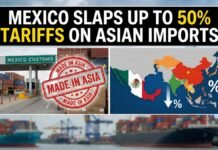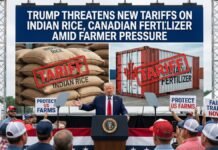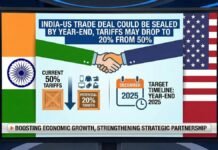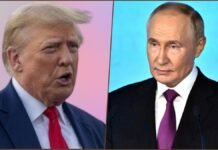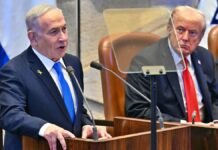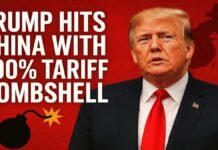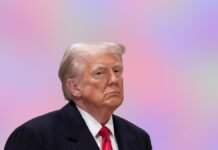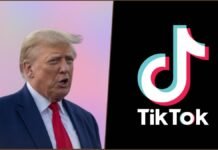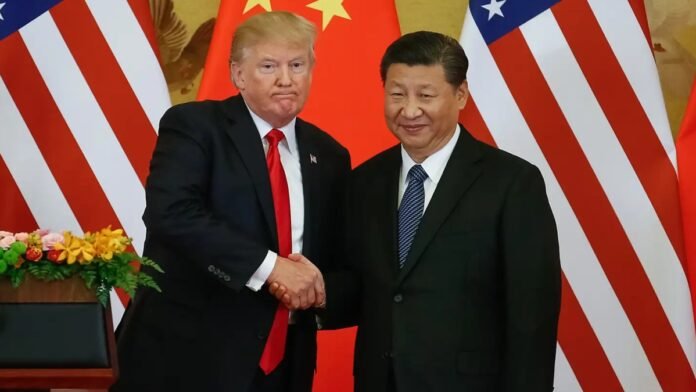
Key Points:
- US President Donald Trump and Chinese President Xi Jinping held their first meeting in six years in Busan, South Korea, on Thursday, October 30, 2025
- The leaders reached a framework trade agreement that averts a potentially devastating 157% tariff on Chinese goods, with Trump calling Xi a “tough negotiator.”
- China agreed to delay rare earth export restrictions for at least one year and resume purchases of US soybeans, while the US will reduce several tariffs
- Trump indicated willingness to lower the 20% fentanyl-related tariff by up to 10% in exchange for China’s enhanced controls on fentanyl precursor chemicals
- The threatened 100% tariff on Chinese goods scheduled for November 1, 2025, is now “essentially off the table”
- Despite the agreement, average US tariffs on Chinese products remain above 55%, while China’s average tariff on US goods stays around 32%
Busan (South Korea): US President Donald Trump and Chinese President Xi Jinping met at an airbase in Busan, South Korea, on Thursday, October 30, 2025, marking their first face-to-face encounter in six years and the first meeting since Trump began his second presidential term. The high-stakes summit took place on the sidelines of the Asia-Pacific Economic Cooperation (APEC) summit in South Korea, where both leaders exchanged cordial greetings and expressed optimism about resolving long-standing trade disputes.
Trump praised Xi as the “great leader of a great country” and described him as a “very tough negotiator,” expressing confidence that the meeting would be “very successful”. Xi responded by saying it was a “great pleasure” to reconnect with Trump after many years, acknowledging that while the two nations do not always see eye to eye, they could “thrive together”.
Framework Agreement to Avert Trade War Escalation
US and Chinese negotiators established a framework agreement during preliminary talks in Kuala Lumpur, Malaysia, successfully averting a potentially ruinous 157% tariff on imports from China. Treasury Secretary Scott Bessent, who headed the US delegation for the fifth round of face-to-face negotiations, stated that the previously threatened 100% tariffs on Chinese goods were “essentially off the table”.
The framework agreement includes several key components: China will postpone its stringent rare earth export restrictions for at least one year and resume significant purchases of US soybeans, while the United States will reduce or remove several tariffs imposed on Chinese goods. Trump also indicated he may reduce the 20% tariff on Chinese exports linked to fentanyl precursor chemicals and cancel plans for the 100% tariff that had been scheduled to take effect on November 1, 2025.
Rare Earth Minerals and Fentanyl Crisis
The issue of rare earth minerals emerged as a critical negotiating point, with China controlling approximately 90% of the world’s supply of these materials essential for electronics, defense systems, and AI technology. China had announced stricter controls on the export of 12 rare earth minerals this year, along with the machinery necessary for refining these metals, citing security concerns.
On the fentanyl crisis, China agreed to enhance controls on the export of precursor chemicals used in fentanyl production, prompting Trump to consider reducing fentanyl-related tariffs by up to 10 percent. Trump stated, “I expect to be lowering that because I believe that they’re going to help us with the fentanyl situation”.
TikTok and Technology Restrictions
The future of Chinese-owned TikTok’s American operations was also on the discussion agenda as part of efforts to steady relations between the world’s two largest economies. Bessent informed CBS that the framework encompasses a “final agreement” regarding TikTok’s operations in the US.
Trump also expressed openness to discussing Chinese access to Nvidia Corp.’s Blackwell AI processors and may end a probe into China’s compliance with trade commitments made during his first term. His administration is expected to ease export controls on certain technologies and roll back levies on Chinese shipping operations.
Xi’s Message on Partnership
Chinese President Xi Jinping emphasized the importance of maintaining the right direction in China-US relations during the opening remarks of the meeting. He told Trump through a translator that trade negotiators from both countries had reached a “basic consensus” on a deal, stating, “A few days ago, in the latest round of consultation, our two economic and trade teams reached a basic consensus on addressing our respective major concerns and made encouraging progress”.
Xi acknowledged that disagreements between the two nations are natural, saying, “We do not always share the same perspective, and it’s typical for the two leading economies to experience disagreements occasionally”. However, he stressed that China and the United States should move forward as partners and friends.
Continued Trade Tensions Despite Progress
While the meeting represents a significant step toward de-escalation, analysts caution that confrontations between Washington and Beijing will persist as both sides compete for influence globally. Despite the framework agreement, a wide range of tariffs, sanctions, and export controls remain in place that impede trade and business interactions between the two nations.
The average US tariff on Chinese products currently exceeds 55 percent, while China’s average tariff on US goods remains around 32 percent. The US has placed hundreds of Chinese companies on a blacklist due to national security concerns and has prohibited exports of advanced chips and critical manufacturing equipment related to artificial intelligence.
Trump’s Asia Tour Context
This meeting with Xi concluded Trump’s five-day Asia tour, during which he finalized agreements with Japan and Southeast Asian nations regarding rare earths, aiming to diminish China’s grip on resources essential for various industries. South Korea was Trump’s third stop on his first Asia tour during his second term, following visits to Malaysia and Japan, where he presided over the signing of a peace deal between Cambodia and Thailand and met newly elected Japanese Prime Minister Sanae Takaichi.
Global Economic Implications
The global economy has been unsettled for months by a series of retaliatory tariffs, export restrictions, and other sanctions affecting various sectors, from advanced technology to international shipping. Stock markets responded favorably to news of the framework agreement, with investors cautiously optimistic that a trade war truce could help sustain bullish sentiment.
APEC brings together 21 member economies that account for over half of global GDP and are home to around 2.7 billion people, representing roughly 40% of the world’s population. The outcomes of the Trump-Xi meeting will significantly impact this economic bloc and global trade dynamics going forward.



































